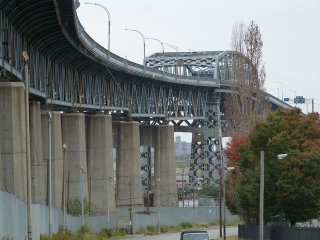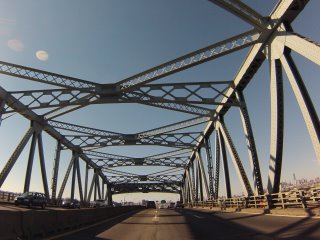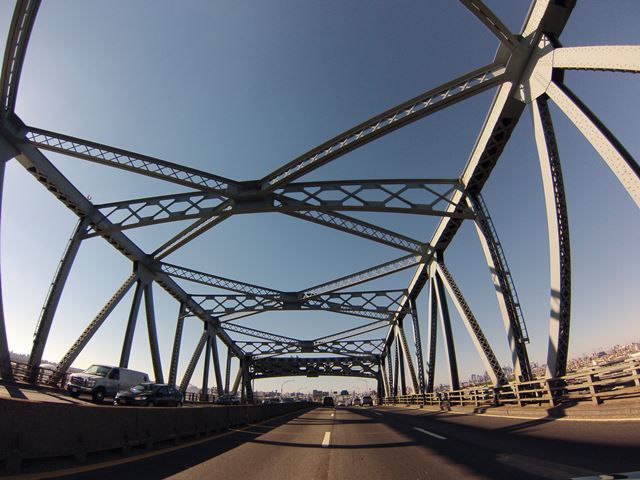We Recommend:
Bach Steel - Experts at historic truss bridge restoration.
Kosciuszko Bridge
Meeker Avenue Bridge

Primary Photographer(s): Nathan Holth
Bridge Documented: October 19-20, 2013
I-278 (Brooklyn - Queens Expressway) Over Newtown Creek and Various Streets
New York: Brooklyn, New York and Queens, New York: United States
Metal 12 Panel Rivet-Connected Polygonal Warren Through Truss, Fixed and Approach Spans: Metal 9 Panel Rivet-Connected Warren Deck Truss, Fixed
1939 By Builder/Contractor: American Bridge Company of New York, New York and Engineer/Design: J. Frank Johnson
1966
300.0 Feet (91.4 Meters)
5,536.0 Feet (1687.4 Meters)
78.7 Feet (23.99 Meters)
1 Main Span(s) and 102 Approach Span(s)
1075699

View Information About HSR Ratings
Bridge Documentation
This bridge no longer exists!
View Archived National Bridge Inventory Report - Has Additional Details and Evaluation
This historic bridge was demolished and replaced in 2017!
Download a ZIP Archive of Selected Final Environmental Impact Statement Documents
View The Historic Resource Inventory Form For This Historic Bridge
View The Final Determination of Eligibility For This Historic Bridge
View Historical Articles About This Bridge
This bridge is a large high level bridge that includes a substantial approach system The bridge includes 10 deck truss spans on the Brooklyn end and 11 deck truss spans on the Queens end. The remaining approach spans are concrete slabs and are part of the connecting viaduct approaches to the bridge. The abutments and viaduct approaches for this bridge are unusual since they are enclosed and faced in red brick, which makes these portions of the bridge look like something from England where such structures are often found. These portions of the "bridge" are not part of the bridge proper however, which is defined by the start of the deck truss spans. However, most sources listing the total length of the bridge appear to include these viaducts in the length measurement.

This bridge was found eligible for listing in the National Register of Historic Places for its engineering significance. The bridge is unique in both design and appearance. Perhaps one of the unusual aspects of this bridge's design is that for a bridge that provides such high clearance for boats, the actual span length of the navigation span (the through truss) is not very substantial at only 300 foot. Where other bridges offering similar navigation vertical clearance might be large cantilever trusses with spans in excess of 500 feet, this bridge's comparatively modest 300 foot span is accommodated by a traditional simple span through truss. This unexpected layout gives this bridge a unique appearance. Another unusual aspect of this bridge is the width of its roadway. With six lanes and only two truss lines, its through truss is very wide compared to most riveted truss bridges. The bridge is also noted for its curved design. The curves add to the engineering complexity of the bridge, and also make for some interesting photos.
As the only interesting structural part of the bridge easily visible to those driving over the bridge is the through truss, many people may never have taken the journey down to the industrial areas under this bridge to appreciate the complexity and beauty of this bridge. Sadly, this bridge was mostly known among the general for its major traffic jams. The bridge is not as busy on Sundays however, which is when HistoricBridges.org documented it. An unfortunate side effect of this is that the fact that traffic was actually moving on the bridge making it impossible to get a decent photo of the bridge's plaques, mounted on the portal bracing of the through truss.

This bridge is unfortunately to be replaced and demolished by a modern bridge that will be devoid of historic significance.
The below photo which was taken in the nearby Calvary Cemetery which offers a good overview of the truss spans of the bridge and is perhaps a fitting photo to conclude this narrative given the fate of this historic bridge. Unlike the gravestones that stand here to remind us of the past, there will be nothing left of the historic Kosciuszko Bridge after it is reduced to scrap metal.

|
Main Plaque CITY OF NEW YORKFIORELLO H. LA GUARDIA MAYOR KOSCIUSZKO BRIDGE DESIGNED AND SUPERVISED BY THE DEPARTMENT OF PUBLIC WORKS
|
Information and Findings From Final Environmental Impact StatementDiscussion of Bridge The Kosciuszko Bridge over Newtown Creek. The Penny Bridge was considered inadequate by the mid-1920s, and discussions of another replacement bridge began to circulate. The commercial and industrial enterprises
in the area continued to grow, and the daily use of the Penny Bridge increased significantly. The bridge's need to allow for waterway traffic to pass by would cause back-ups with the vehicular traffic as it waited for the bridge to
turn back landwards. In addition, the design of the Penny Bridge caused "bottlenecks" on the creek. The process of ships passing through the creek by the Penny Bridge was difficult because of the width of the creek at that point, a
mere 144 feet wide. "The bridge ahead, like a turnstile, pivots on an island one-third as wide as the waterway...the creek ...cannot be deepened there [because] the bridge foundations would collapse" (Brooklyn Eagle, August 4,
1939a:13). Local businessmen and the Borough Chamber hoped a new bridge would allow the creek to be widened considerably at this location and allow for a substantial increase in business for industries in both Queens and Brooklyn. |
![]()
Photo Galleries and Videos: Kosciuszko Bridge
About - Contact
© Copyright 2003-2024, HistoricBridges.org. All Rights Reserved. Disclaimer: HistoricBridges.org is a volunteer group of private citizens. HistoricBridges.org is NOT a government agency, does not represent or work with any governmental agencies, nor is it in any way associated with any government agency or any non-profit organization. While we strive for accuracy in our factual content, HistoricBridges.org offers no guarantee of accuracy. Information is provided "as is" without warranty of any kind, either expressed or implied. Information could include technical inaccuracies or errors of omission. Opinions and commentary are the opinions of the respective HistoricBridges.org member who made them and do not necessarily represent the views of anyone else, including any outside photographers whose images may appear on the page in which the commentary appears. HistoricBridges.org does not bear any responsibility for any consequences resulting from the use of this or any other HistoricBridges.org information. Owners and users of bridges have the responsibility of correctly following all applicable laws, rules, and regulations, regardless of any HistoricBridges.org information.
![]()




